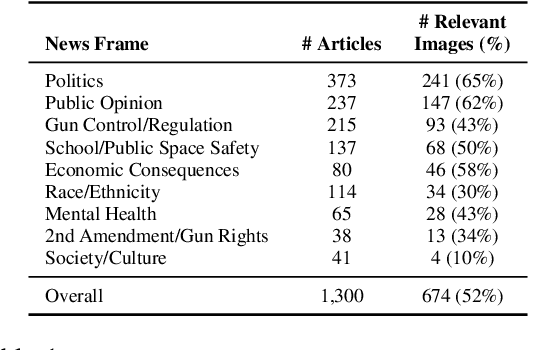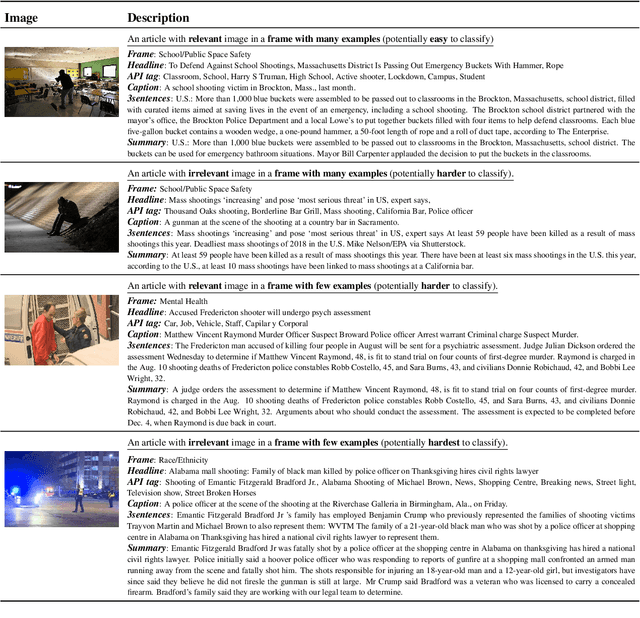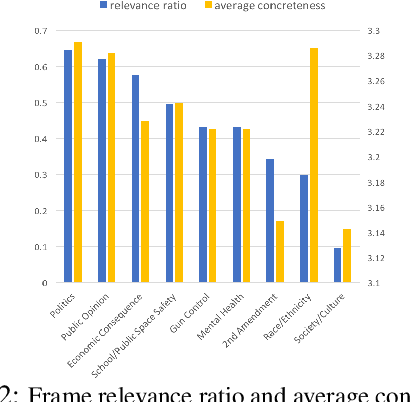Lei Guo
Semantic-enhanced Co-attention Prompt Learning for Non-overlapping Cross-Domain Recommendation
May 25, 2025Abstract:Non-overlapping Cross-domain Sequential Recommendation (NCSR) is the task that focuses on domain knowledge transfer without overlapping entities. Compared with traditional Cross-domain Sequential Recommendation (CSR), NCSR poses several challenges: 1) NCSR methods often rely on explicit item IDs, overlooking semantic information among entities. 2) Existing CSR mainly relies on domain alignment for knowledge transfer, risking semantic loss during alignment. 3) Most previous studies do not consider the many-to-one characteristic, which is challenging because of the utilization of multiple source domains. Given the above challenges, we introduce the prompt learning technique for Many-to-one Non-overlapping Cross-domain Sequential Recommendation (MNCSR) and propose a Text-enhanced Co-attention Prompt Learning Paradigm (TCPLP). Specifically, we capture semantic meanings by representing items through text rather than IDs, leveraging natural language universality to facilitate cross-domain knowledge transfer. Unlike prior works that need to conduct domain alignment, we directly learn transferable domain information, where two types of prompts, i.e., domain-shared and domain-specific prompts, are devised, with a co-attention-based network for prompt encoding. Then, we develop a two-stage learning strategy, i.e., pre-train & prompt-tuning paradigm, for domain knowledge pre-learning and transferring, respectively. We conduct extensive experiments on three datasets and the experimental results demonstrate the superiority of our TCPLP. Our source codes have been publicly released.
Adaptive Sentencing Prediction with Guaranteed Accuracy and Legal Interpretability
May 20, 2025Abstract:Existing research on judicial sentencing prediction predominantly relies on end-to-end models, which often neglect the inherent sentencing logic and lack interpretability-a critical requirement for both scholarly research and judicial practice. To address this challenge, we make three key contributions:First, we propose a novel Saturated Mechanistic Sentencing (SMS) model, which provides inherent legal interpretability by virtue of its foundation in China's Criminal Law. We also introduce the corresponding Momentum Least Mean Squares (MLMS) adaptive algorithm for this model. Second, for the MLMS algorithm based adaptive sentencing predictor, we establish a mathematical theory on the accuracy of adaptive prediction without resorting to any stationarity and independence assumptions on the data. We also provide a best possible upper bound for the prediction accuracy achievable by the best predictor designed in the known parameters case. Third, we construct a Chinese Intentional Bodily Harm (CIBH) dataset. Utilizing this real-world data, extensive experiments demonstrate that our approach achieves a prediction accuracy that is not far from the best possible theoretical upper bound, validating both the model's suitability and the algorithm's accuracy.
Federated Semantic Learning for Privacy-preserving Cross-domain Recommendation
Mar 29, 2025Abstract:In the evolving landscape of recommender systems, the challenge of effectively conducting privacy-preserving Cross-Domain Recommendation (CDR), especially under strict non-overlapping constraints, has emerged as a key focus. Despite extensive research has made significant progress, several limitations still exist: 1) Previous semantic-based methods fail to deeply exploit rich textual information, since they quantize the text into codes, losing its original rich semantics. 2) The current solution solely relies on the text-modality, while the synergistic effects with the ID-modality are ignored. 3) Existing studies do not consider the impact of irrelevant semantic features, leading to inaccurate semantic representation. To address these challenges, we introduce federated semantic learning and devise FFMSR as our solution. For Limitation 1, we locally learn items'semantic encodings from their original texts by a multi-layer semantic encoder, and then cluster them on the server to facilitate the transfer of semantic knowledge between domains. To tackle Limitation 2, we integrate both ID and Text modalities on the clients, and utilize them to learn different aspects of items. To handle Limitation 3, a Fast Fourier Transform (FFT)-based filter and a gating mechanism are developed to alleviate the impact of irrelevant semantic information in the local model. We conduct extensive experiments on two real-world datasets, and the results demonstrate the superiority of our FFMSR method over other SOTA methods. Our source codes are publicly available at: https://github.com/Sapphire-star/FFMSR.
BadRefSR: Backdoor Attacks Against Reference-based Image Super Resolution
Feb 28, 2025Abstract:Reference-based image super-resolution (RefSR) represents a promising advancement in super-resolution (SR). In contrast to single-image super-resolution (SISR), RefSR leverages an additional reference image to help recover high-frequency details, yet its vulnerability to backdoor attacks has not been explored. To fill this research gap, we propose a novel attack framework called BadRefSR, which embeds backdoors in the RefSR model by adding triggers to the reference images and training with a mixed loss function. Extensive experiments across various backdoor attack settings demonstrate the effectiveness of BadRefSR. The compromised RefSR network performs normally on clean input images, while outputting attacker-specified target images on triggered input images. Our study aims to alert researchers to the potential backdoor risks in RefSR. Codes are available at https://github.com/xuefusiji/BadRefSR.
Feedback Favors the Generalization of Neural ODEs
Oct 14, 2024



Abstract:The well-known generalization problem hinders the application of artificial neural networks in continuous-time prediction tasks with varying latent dynamics. In sharp contrast, biological systems can neatly adapt to evolving environments benefiting from real-time feedback mechanisms. Inspired by the feedback philosophy, we present feedback neural networks, showing that a feedback loop can flexibly correct the learned latent dynamics of neural ordinary differential equations (neural ODEs), leading to a prominent generalization improvement. The feedback neural network is a novel two-DOF neural network, which possesses robust performance in unseen scenarios with no loss of accuracy performance on previous tasks. A linear feedback form is presented to correct the learned latent dynamics firstly, with a convergence guarantee. Then, domain randomization is utilized to learn a nonlinear neural feedback form. Finally, extensive tests including trajectory prediction of a real irregular object and model predictive control of a quadrotor with various uncertainties, are implemented, indicating significant improvements over state-of-the-art model-based and learning-based methods.
3D-CT-GPT: Generating 3D Radiology Reports through Integration of Large Vision-Language Models
Sep 28, 2024



Abstract:Medical image analysis is crucial in modern radiological diagnostics, especially given the exponential growth in medical imaging data. The demand for automated report generation systems has become increasingly urgent. While prior research has mainly focused on using machine learning and multimodal language models for 2D medical images, the generation of reports for 3D medical images has been less explored due to data scarcity and computational complexities. This paper introduces 3D-CT-GPT, a Visual Question Answering (VQA)-based medical visual language model specifically designed for generating radiology reports from 3D CT scans, particularly chest CTs. Extensive experiments on both public and private datasets demonstrate that 3D-CT-GPT significantly outperforms existing methods in terms of report accuracy and quality. Although current methods are few, including the partially open-source CT2Rep and the open-source M3D, we ensured fair comparison through appropriate data conversion and evaluation methodologies. Experimental results indicate that 3D-CT-GPT enhances diagnostic accuracy and report coherence, establishing itself as a robust solution for clinical radiology report generation. Future work will focus on expanding the dataset and further optimizing the model to enhance its performance and applicability.
A Survey of Foundation Models for Music Understanding
Sep 15, 2024Abstract:Music is essential in daily life, fulfilling emotional and entertainment needs, and connecting us personally, socially, and culturally. A better understanding of music can enhance our emotions, cognitive skills, and cultural connections. The rapid advancement of artificial intelligence (AI) has introduced new ways to analyze music, aiming to replicate human understanding of music and provide related services. While the traditional models focused on audio features and simple tasks, the recent development of large language models (LLMs) and foundation models (FMs), which excel in various fields by integrating semantic information and demonstrating strong reasoning abilities, could capture complex musical features and patterns, integrate music with language and incorporate rich musical, emotional and psychological knowledge. Therefore, they have the potential in handling complex music understanding tasks from a semantic perspective, producing outputs closer to human perception. This work, to our best knowledge, is one of the early reviews of the intersection of AI techniques and music understanding. We investigated, analyzed, and tested recent large-scale music foundation models in respect of their music comprehension abilities. We also discussed their limitations and proposed possible future directions, offering insights for researchers in this field.
Diffusion-Driven Semantic Communication for Generative Models with Bandwidth Constraints
Jul 26, 2024Abstract:Diffusion models have been extensively utilized in AI-generated content (AIGC) in recent years, thanks to the superior generation capabilities. Combining with semantic communications, diffusion models are used for tasks such as denoising, data reconstruction, and content generation. However, existing diffusion-based generative models do not consider the stringent bandwidth limitation, which limits its application in wireless communication. This paper introduces a diffusion-driven semantic communication framework with advanced VAE-based compression for bandwidth-constrained generative model. Our designed architecture utilizes the diffusion model, where the signal transmission process through the wireless channel acts as the forward process in diffusion. To reduce bandwidth requirements, we incorporate a downsampling module and a paired upsampling module based on a variational auto-encoder with reparameterization at the receiver to ensure that the recovered features conform to the Gaussian distribution. Furthermore, we derive the loss function for our proposed system and evaluate its performance through comprehensive experiments. Our experimental results demonstrate significant improvements in pixel-level metrics such as peak signal to noise ratio (PSNR) and semantic metrics like learned perceptual image patch similarity (LPIPS). These enhancements are more profound regarding the compression rates and SNR compared to deep joint source-channel coding (DJSCC).
Disturbance Observer for Estimating Coupled Disturbances
Jul 18, 2024


Abstract:High-precision control for nonlinear systems is impeded by the low-fidelity dynamical model and external disturbance. Especially, the intricate coupling between internal uncertainty and external disturbance is usually difficult to be modeled explicitly. Here we show an effective and convergent algorithm enabling accurate estimation of the coupled disturbance via combining control and learning philosophies. Specifically, by resorting to Chebyshev series expansion, the coupled disturbance is firstly decomposed into an unknown parameter matrix and two known structures depending on system state and external disturbance respectively. A Regularized Least Squares (RLS) algorithm is subsequently formalized to learn the parameter matrix by using historical time-series data. Finally, a higher-order disturbance observer (HODO) is developed to achieve a high-precision estimation of the coupled disturbance by utilizing the learned portion. The efficiency of the proposed algorithm is evaluated through extensive simulations. We believe this work can offer a new option to merge learning schemes into the control framework for addressing existing intractable control problems.
Detecting Frames in News Headlines and Lead Images in U.S. Gun Violence Coverage
Jun 25, 2024



Abstract:News media structure their reporting of events or issues using certain perspectives. When describing an incident involving gun violence, for example, some journalists may focus on mental health or gun regulation, while others may emphasize the discussion of gun rights. Such perspectives are called \say{frames} in communication research. We study, for the first time, the value of combining lead images and their contextual information with text to identify the frame of a given news article. We observe that using multiple modes of information(article- and image-derived features) improves prediction of news frames over any single mode of information when the images are relevant to the frames of the headlines. We also observe that frame image relevance is related to the ease of conveying frames via images, which we call frame concreteness. Additionally, we release the first multimodal news framing dataset related to gun violence in the U.S., curated and annotated by communication researchers. The dataset will allow researchers to further examine the use of multiple information modalities for studying media framing.
 Add to Chrome
Add to Chrome Add to Firefox
Add to Firefox Add to Edge
Add to Edge